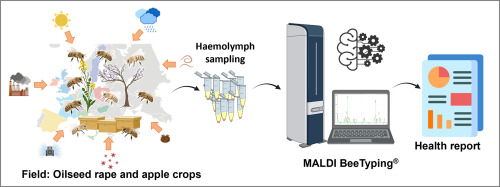pan-european assessment, monitoring, and mitigation of stressors on the health of bees
A blood test to monitor bee health across an EU network of agricultural sites
A new PoshBee paper published in the ScienceDirect journal investigates how some environmental and management factors under field conditions across Europe affected the honey bee haemolymph peptidome.

There are substantial concerns about impaired honey bee health and colony losses due to several poorly understood factors. We used MALDI profiling (MALDI BeeTyping®) analysis to investigate how some environmental and management factors under field conditions across Europe affected the honey bee haemolymph peptidome (all peptides in the circulatory fluid), as a profile of molecular markers representing the immune status of Apis mellifera. Honey bees were exposed to a range of environmental stressors in 128 agricultural sites across eight European countries in four biogeographic zones, with each country contributing eight sites each for two different cropping systems: oilseed rape (OSR) and apple (APP). The full haemolymph peptide profiles, including the presence and levels of three key immunity markers, namely the antimicrobial peptides (AMPs) Apidaecin, Abaecin and Defensin-1, allowed the honey bee responses to environmental variables to be discriminated by country, crop type and site. When considering just the AMPs, it was not possible to distinguish between countries by the prevalence of each AMP in the samples. However, it was possible to discriminate between countries on the amounts of the AMPs, with the Swedish samples in particular expressing high amounts of all AMPs. A machine learning model was developed to discriminate the haemolymphs of bees from APP and OSR sites. The model was 90.6 % accurate in identifying the crop type from the samples used to build the model. Overall, MALDI BeeTyping® of bee haemolymph represents a promising and cost-effective "blood test" for simultaneously monitoring dozens of peptide markers affected by environmental stressors at the landscape scale, thus providing policymakers with new diagnostic and regulatory tools for monitoring bee health.
You can read the full paper here.